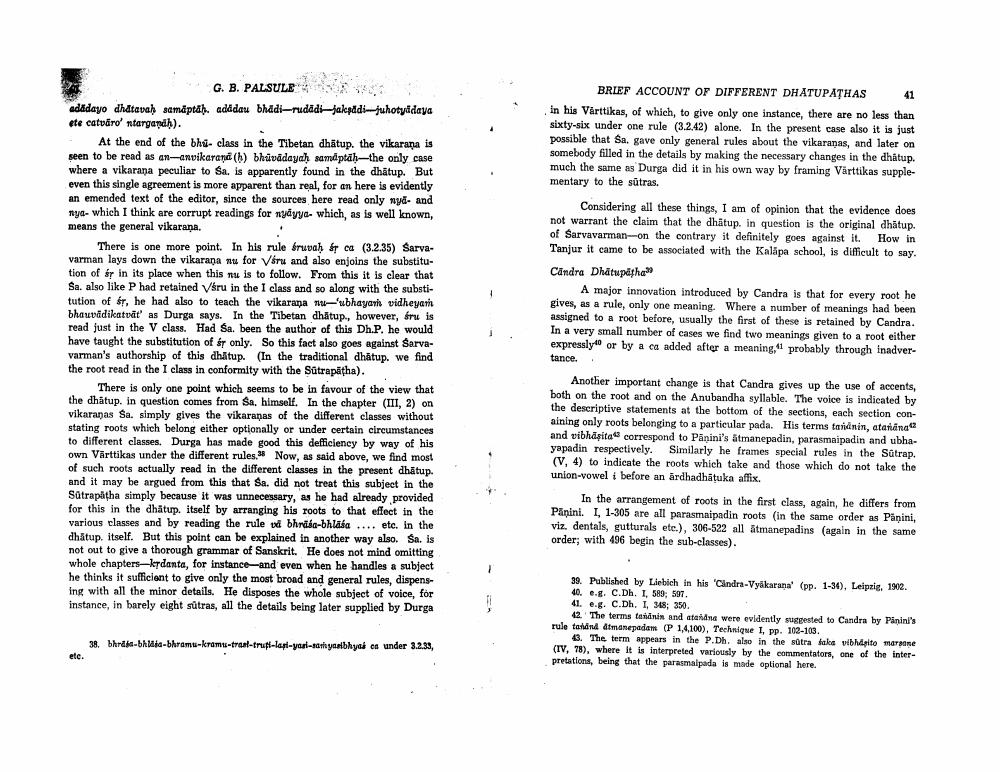Book Title: Brief Account Of Different Dhatupatras Author(s): G B Palsule Publisher: G B Palsule View full book textPage 3
________________ BRIEF ACCOUNT OF DIFFERENT DHATUPATHAS 41 In his Virttikas, of which, to give only one instance, there are no less than sixty-six under one rule (3.2.42) alone. In the present case also it is just possible that Sa. gave only general rules about the vikaranas, and later on somebody filled in the details by making the necessary changes in the dhatup. much the same as Durga did it in his own way by framing Värttikas supplementary to the sutras. G. B. PALSULES adadayo dhatavah samdptáh. adddau bhadirudddi-jakad juhotyldaya ete catvaro' ntargandh). At the end of the bhi- class in the Tibetan dhätup. the vikarana is seen to be read as on- vikarama(h) bhūvddayah sampdh-the only case where a vikarana peculiar to Sa is apparently found in the dhätup. But even this single agreement is more apparent than real, for an here is evidently an emended text of the editor, since the sources here read only nyd. and nya- which I think are corrupt readings for nydyye. which, as is well known, means the general vikarana. There is one more point. In his rule bruvah & ca (3.2.35) Sarvavarman lays down the vikarana nu for Viru and also enjoins the substitution of br in its place when this nu is to follow. From this it is clear that Sa. also like P had retained Varu in the I class and so along with the substitution of $r, he had also to teach the vikarana m u bhayari vidheyath bhauvidikatvat" as Durga says. In the Tibetan dhatup. however, bruis read just in the V class. Had Sa. been the author of this Dh.P. he would have taught the substitution of or only. So this fact also goes against Sarvavarman's authorship of this dhatup. (In the traditional dhatup. we find the root read in the I class in conformity with the Sütrapatha). There is only one point which seems to be in favour of the view that the dhatup. in question comes from Sa. himself. In the chapter (III, 2) on vikaranas Sa. simply gives the vikaranas of the different classes without stating roots which belong either optionally or under certain circumstances to different classes. Durga has made good this defficiency by way of his own Värttikas under the different rules. Now, as said above, we find most of such roots actually read in the different classes in the present dhātup. and it may be argued from this that Sa. did not treat this subject in the Satrapatha simply because it was unnecessary, as he had already provided for this in the dhatup. itself by arranging his roots to that effect in the various classes and by reading the rule od bhrase-bhlasa.... etc. in the dhatup, itself. But this point can be explained in another way also. Sa is not out to give a thorough grammar of Sanskrit. He does not mind omitting whole chapters-kydanta, for instance and even when he handles a subject he thinks it sufficient to give only the most broad and general rules, dispensing with all the minor details. He disposes the whole subject of voice, for instance, in barely eight sútras, all the details being later supplied by Durga Considering all these things, I am of opinion that the evidence does not warrant the claim that the dhatup. in question is the original dhätup. of Sarvavarman on the contrary it definitely goes against it. How in Tanjur it came to be associated with the Kalapa school, is difficult to say. Candra Dhātupátha." A major innovation introduced by Candra is that for every root ho gives, as a rule, only one meaning. Where a number of meanings had been assigned to a root before, usually the first of these is retained by Candra. In a very small number of cases we find two meanings given to a root either expressly or by a ca added after a meaning, probably through inadvertance. . Another important change is that Candra gives up the use of accents, both on the root and on the Anubandha syllable. The voice is indicated by the descriptive statements at the bottom of the sections, each section conaining only roots belonging to a particular pada. His terms tunin, atafuna and vibhasita correspond to Panini's ātmanepadin, perasmnipadin and ubhayapadin respectively. Similarly he frames special rules in the Satrap. (V, 4) to indicate the roots which take and those which do not take the union-vowel before an ārdhadhatuka affix. In the arrangement of roots in the first class, again, he differs from Pånini. I. 1-305 are all parasmaipadin roots in the same order as Panini, viz. dentals, gutturals etc.), 306-522 all åtmanepadins (again in the same order; with 496 begin the sub-classes). 39. Published by Lebich in his 'Cindra-Vyakarana (pp. 1-34), Leipzig. 1912. 40. e.g. C.Dh. I, 589, 597 41. e.g. C.Dh, I, 318; 350. 12 The terms this and ateins were evidently suggested to Candra by Panini's rule tahand atmonepadam (P 1,4,100), Technique I, pp. 102-103. 43. The term appears in the P.Dh, also in the sotra faks vibhipito marrone (IV, 78), where it is interpreted variously by the commentators, one of the Inter pretations, being that the parasmalpada is made optional here. 3 bhris-bh Mha-bhramu-kamu-traal-trup-lapl-yol-aayaibhyad on under 3.2.38, ete.Page Navigation
1 2 3 4 5 6 7 8 9
